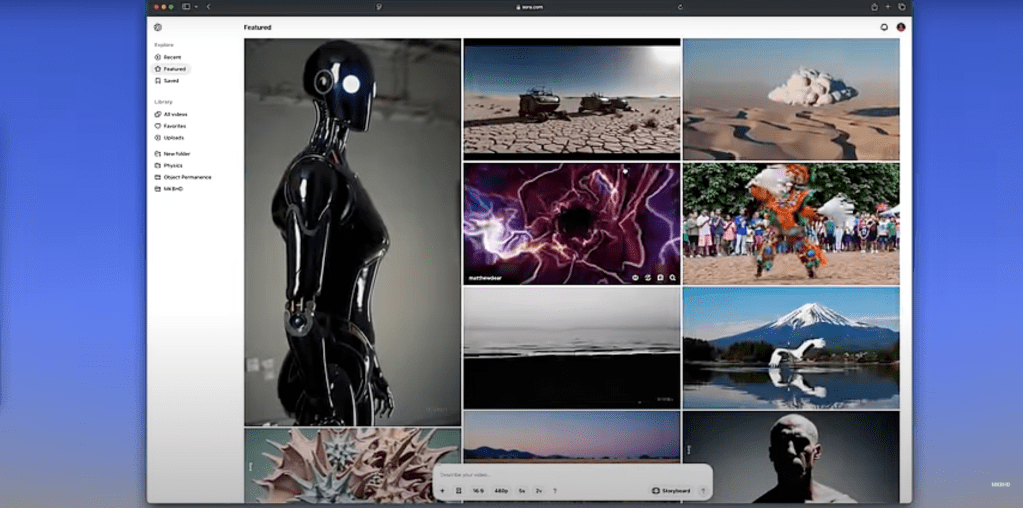Join our daily and weekly newsletters for the latest updates and exclusive content on industry-leading AI coverage. Learn More
OpenAI announced the public release of its hyperrealistic AI video generation software Sora today — nearly 10 months after it was first shown publicly in February 2024.
In fact, OpenAI is actually releasing a much upgraded model from the one debuted back then: The new Sora Turbo will be available at sora.com to ChatGPT Plus and Pro paying subscribers ($20/month or $200/month) for those in the U.S. and most countries outside of the EU and UK.
OpenAI cofounder and CEO Sam Altman presented the news in a YouTube livestream, part of the company’s “12 Days of OpenAI” series of holiday-themed announcements scheduled for 1 pm ET / 10 am PT.
Sora can generate a wide range of videos from text inputs or still images, creating clips between 10 and 20 seconds long, and do so in a range of resolutions from 480p to 1080p, as well as aspect ratios from landscape to square and vertical.
OpenAI created a whole new unique interface for the product, which includes a grid or list view the user can toggle within to see their generations.
Users can also enter a mode called Storyboarding which lets them generate multiple linked clips in a Timeline view. The model attempts to provide a seamless transition between the clips — users can drag to make cuts more abrupt or make takes longer and more fluid.
ChatGPT Plus users can generate up to 50 videos per month at 480p resolution.
For professionals and heavy users, the Pro plan offers higher resolutions, longer durations, and unlimited generations at slow speeds.
OpenAI also announced plans to release tailored pricing options for diverse user needs by early 2025.
News broken by MKBHD
Popular tech reviewing YouTuber Marques Brownlee, better known by his handle MKHBD, broke the news of Sora’s release about an hour beforehand.
“The rumors are true — SORA, OpenAI’s AI video generator, is launching for the public today…” Brownlee wrote in a post on the social network X.
Brownlee also shared a thread of examples of videos he made using the text/image/video-to-video generator, to which he was given early access as one among several dozen early creative partners to whom OpenAI seeded the program before its general release.
Brownlee shared that while Sora could produce impressive and sometimes eerily realistic footage such as that of newscasters or a gadget reviewer like himself, it also tends to hallucinate random details and telltale signs of being AI-generated, such as garbled, nonsensical text in news chyrons, unnatural physics, and even adding or removing objects seemingly at random.
He also noted that OpenAI imposes fairly strict guardrails against generating likenesses of real people and against violence and explicit themes.
Still, in his full YouTube review, he also ultimately concluded that “this is a lot for humanity to digest now…[it] is the new baseline, this is once again the worst that it will ever be.”
Leaked on Hugging Face in protest by early testers
The release follows a leak of Sora onto the AI code sharing community Hugging Face by beta testers roughly two weeks ago in protest of OpenAI’s handling of the beta testing program. As the leakers wrote on their Hugging Face space:
“Hundreds of artists provide unpaid labor through bug testing, feedback and experimental work for the program for a $150B valued company. While hundreds contribute for free, a select few will be chosen through a competition to have their Sora-created films screened — offering minimal compensation which pales in comparison to the substantial PR and marketing value OpenAI receives.”
Sora also arrives in the midst of an increasingly competitive landscape for realistic, live-action AI video generation. Runway continues to upgrade its AI video generation platform rapidly with new features including, just last week, the ability to re-record dialog in pre-existing footage and have the characters’ faces match. Luma AI and Chinese competitors such as Kling, Hailuo, and recently, Tencent, have all fielded impressive AI video generation tools in the last few weeks alone.
So even though OpenAI — by virtue of its success with ChatGPT and early, eye-catching Sora footage — may have strong recognition that can help popularize the launch of this new AI video generator to the masses, there are now many competing options that appear, at least superficially, to offer similar or better video quality. That makes Sora less of a guaranteed success.
Source link

